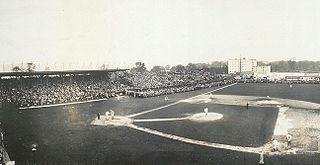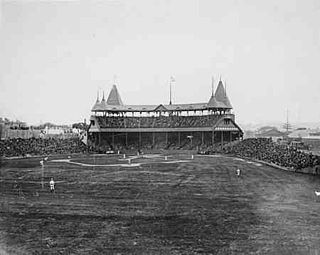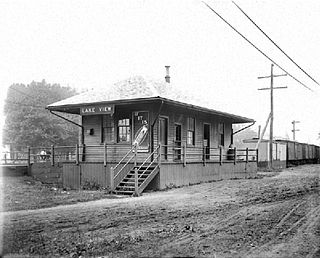Related Research Articles

The San Francisco Giants are an American professional baseball team based in San Francisco. The Giants compete in Major League Baseball (MLB) as a member club of the National League (NL) West Division. Founded in 1883 as the New York Gothams, the team was renamed the New York Giants three years later, eventually relocating from New York City to San Francisco in 1958. The Giants play their home games in Oracle Park in San Francisco.

Oracle Park is a baseball stadium in the SoMa district of San Francisco, California. Since 2000, it has served as the ballpark of Major League Baseball's San Francisco Giants. Previously named Pacific Bell Park, SBC Park, and AT&T Park, the stadium's current name was purchased by the Oracle Corporation in 2019.

The Polo Grounds was the name of three stadiums in Upper Manhattan, New York City, used mainly for professional baseball and American football from 1880 to 1963. The original Polo Grounds, opened in 1876 and demolished in 1889, was built for the sport of polo. Bound on the south and north by 110th and 112th streets and on the east and west by Fifth and Sixth (Lenox) avenues, just north of Central Park, it was converted to a baseball stadium when leased by the New York Metropolitans in 1880.

Coogan's Bluff is a promontory near the western shore of the Harlem River in the Washington Heights neighborhood of Upper Manhattan in New York City. Its boundaries extend approximately from 155th Street and the Macombs Dam Bridge viaduct to 160th Street, between Edgecombe Avenue and the river. A deep escarpment descends 175 feet (53 m) from Edgecombe Avenue to the river, creating a sheltered area between the bluff and river known as Coogan's Hollow. From 1890 to 1964, the hollow was home to the Polo Grounds sports stadium.

Hilltop Park was the nickname of a baseball park that stood in the Washington Heights neighborhood of Manhattan. It was the home of the New York Yankees of Major League Baseball from 1903 to 1912 when they were known as the "Highlanders". It was also the temporary home of the New York Giants during a two-month period in 1911 while the Polo Grounds was being rebuilt after a fire.

South End Grounds refers to any one of three baseball parks on one site in Boston, Massachusetts. They were home to the franchise that eventually became known as the Boston Braves, first in the National Association and later in the National League, from 1871 through part of the 1914 season. That stretch of 43 1/2 seasons is still the longest tenure of the Braves club at any of their various ballparks and cities since 1914.

The Metropolitan Club was a 19th-century professional baseball team that played in New York City from 1880 to 1887.
Olympic Park is the name shared by two former baseball grounds located in Buffalo, New York, United States.

St. George Cricket Grounds or more properly just St. George Grounds is a former baseball venue located on Staten Island, New York. St. George was the home park for the New York Metropolitans of the American Association for the 1886 and 1887 seasons. The grounds were also a part-time home to the New York Giants of the National League in 1889.

Phoenix Municipal Stadium is a baseball stadium, located in Phoenix, Arizona. It is often referred in short as Phoenix Muni. The stadium was built in 1964 and holds 8,775 people. It is currently the home to the Arizona State Sun Devils baseball program, having relocated to Phoenix Municipal Stadium at the start of their 2015 season. It is the former spring training home to the Oakland A's, having played their home games from 1982 to 2014. The San Francisco Giants held spring training at the ballpark from 1964 to 1981, when they moved to Scottsdale Stadium.

The Elysian Fields in Hoboken, New Jersey, was recreational parkland located on the city's northern riverfront in the 19th century. The area was a popular getaway destination for New Yorkers in the 19th century, much in the tradition of the pleasure garden, offering open space for a variety of sports, public spectacles, and amusements. The lavish grounds hosted the Colonnade Hotel and tavern, and offered picnic areas, a spa known as Sybil's Cave, river walks, nature paths, fishing, a miniature railroad, rides and races, and a ferry landing, which also served as a launch for boating competitions.
The following are the baseball events of the year 1912 throughout the world.

The Brooklyn Dodgers were a Major League Baseball team founded in 1883 as the Brooklyn Grays, next year in 1884 becoming a member of the American Association as the Brooklyn Atlantics before joining the National League in 1890. They remained in Brooklyn until 1957, after which the club moved to Los Angeles, California, where it continues its history as the Los Angeles Dodgers. The team moved west at the same time as its longtime rival, the New York Giants, moved to San Francisco in northern California as the San Francisco Giants.

Lake View is a former railroad station for the Erie Railroad in the community of Paterson, New Jersey. The station was located at the intersection of Railway Avenue and Crooks Avenue in the Lakeview district of Paterson, just north of the Clifton town line. The station consisted of two platforms, with a small shelter-sized depot on the westbound tracks and no shelter whatsoever on the eastbound side heading towards Pavonia Terminal. The station was first opened in 1883 in the Lakeview district, and remained in use for nearly eight decades. In 1952 and 1953, as a deal made for Passaic, New Jersey, stations at Clifton and Main Street-Passaic were rebuilt. However, Lake View was not, and when the Passaic Plan was enacted on April 2, 1963, the last passenger trains served Lake View served the old 1883 depot. The depot was razed in the autumn of 1967.
West Side Park was the name of two different baseball parks in Jersey City, New Jersey in the early 20th Century. Both parks were also called Skeeters Park in reference to the long-time nickname of the teams, the "Jersey City Skeeters", so called because of the many mosquitoes ("skeeters") which lived in Jersey City's marsh lands.
References
- 1 2 "1889 Log For Oakland Park in Jersey City, NJ". retrosheet.org. Retrieved May 2, 2024.
- 1 2 "Giants Ballparks: 1883–Present". Sanfrancisco.giants.mlb.com. Archived from the original on May 27, 2011. Retrieved May 2, 2024.
- 1 2 "Oakland Park (Jersey City, NJ)". Society for American Baseball Research (SABR). Retrieved May 6, 2024.
- ↑ "The Sunday Tatler and Jersey City Express., April 19, 1885, Image 2 - Sporting Notes". The Sunday Tatler and Jersey City Express. April 19, 1885. Retrieved May 3, 2024.
- 1 2 "The Sunday Tatler and Jersey City Express., April 26, 1885, Image 2 - Sporting Notes". The Sunday Tatler and Jersey City Express. April 26, 1885. Retrieved May 3, 2024.
- 1 2 "The New York Sun. [volume], February 26, 1888, Page 7, Image 7 - New Ground Secured For The Jersey City Club". The New York Sun. February 26, 1888. Retrieved May 2, 2024.
- ↑ "The Evening World. [volume], April 19, 1888, Baseball Extra, Image 1 - Jersey City Beats Syracuse. An Auspicious Opening of the Oakland Park Grounds To-Day". The World Evening Edition. April 19, 1888. Retrieved May 3, 2024.
- ↑ "New York Tribune. [volume], February 10, 1889, Page 13, Image 13 - Seeking Pastures New. Polo Grounds Cut Up At Last". New York Tribune. February 10, 1889. Retrieved May 2, 2024.
- 1 2 "The Evening World. [volume], February 12, 1889, Extra 2 o'clock, page 4, image 4 - Where Will The Giants Go?". The World Evening Edition. February 12, 1889. Retrieved May 3, 2024.
- ↑ "The Evening World. [volume], September 03, 1888, 5 o'clock, image 1 - Giants Way Down, They Are But Liliputians To Jersey City's Ball Players". The World Evening Edition. September 3, 1888. Retrieved May 2, 2024.
40°44′03″N74°03′20″W / 40.734047°N 74.055565°W